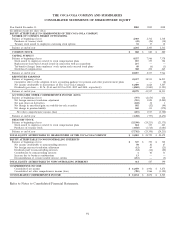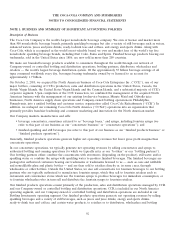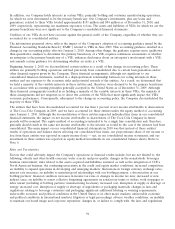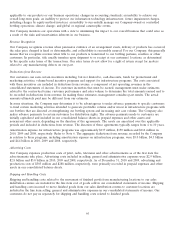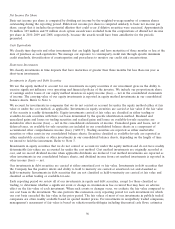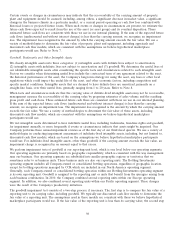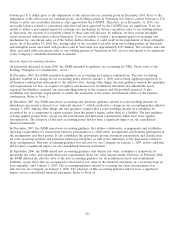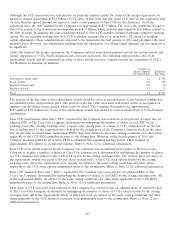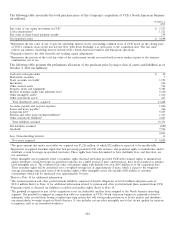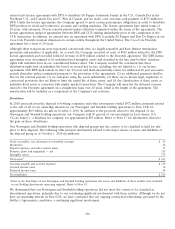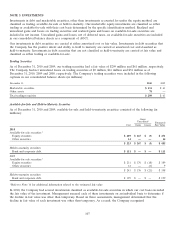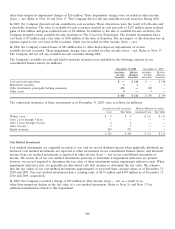Coca Cola 2010 Annual Report Download - page 101
Download and view the complete annual report
Please find page 101 of the 2010 Coca Cola annual report below. You can navigate through the pages in the report by either clicking on the pages listed below, or by using the keyword search tool below to find specific information within the annual report.of the impairment test must be performed in order to determine the amount of impairment loss, if any. The second
step compares the implied fair value of the reporting unit goodwill with the carrying amount of that goodwill. If the
carrying amount of the reporting unit’s goodwill exceeds its implied fair value, an impairment charge is recognized in an
amount equal to that excess. The loss recognized cannot exceed the carrying amount of goodwill.
Impairment charges related to intangible assets are generally recorded in the line item other operating charges or, to
the extent they relate to equity method investees, in the line item equity income (loss) — net in the consolidated
statements of income.
Contingencies
Our Company is involved in various legal proceedings and tax matters. Due to their nature, such legal proceedings and
tax matters involve inherent uncertainties including, but not limited to, court rulings, negotiations between affected
parties and governmental actions. Management assesses the probability of loss for such contingencies and accrues a
liability and/or discloses the relevant circumstances, as appropriate. Refer to Note 11.
Stock-Based Compensation
Our Company currently sponsors stock option plans and restricted stock award plans. The fair values of the stock
awards are determined using an estimated expected life. The Company recognizes compensation expense on a
straight-line basis over the period the award is earned by the employee. Refer to Note 12.
Pension and Other Postretirement Benefit Plans
Our Company sponsors and/or contributes to pension and postretirement health care and life insurance benefit plans
covering substantially all U.S. employees. We also sponsor nonqualified, unfunded defined benefit pension plans for
certain associates and participate in multi-employer pension plans in the United States. In addition, our Company and
its subsidiaries have various pension plans and other forms of postretirement arrangements outside the United States.
Refer to Note 13.
Income Taxes
Income tax expense includes United States, state, local and international income taxes, plus a provision for U.S. taxes
on undistributed earnings of foreign subsidiaries not deemed to be indefinitely reinvested. Deferred tax assets and
liabilities are recognized for the tax consequences of temporary differences between the financial reporting basis and
the tax basis of existing assets and liabilities. The tax rate used to determine the deferred tax assets and liabilities is the
enacted tax rate for the year and manner in which the differences are expected to reverse. Valuation allowances are
recorded to reduce deferred tax assets to the amount that will more likely than not be realized. The Company records
taxes that are collected from customers and remitted to governmental authorities on a net basis in our consolidated
statements of income.
The Company is involved in various tax matters, with respect to some of which the outcome is uncertain. We establish
reserves to remove some or all of the tax benefit of any of our tax positions at the time we determine that it becomes
uncertain based upon one of the following conditions: (1) the tax position is not ‘‘more likely than not’’ to be sustained,
(2) the tax position is ‘‘more likely than not’’ to be sustained, but for a lesser amount, or (3) the tax position is ‘‘more
likely than not’’ to be sustained, but not in the financial period in which the tax position was originally taken. For
purposes of evaluating whether or not a tax position is uncertain, (1) we presume the tax position will be examined by
the relevant taxing authority that has full knowledge of all relevant information; (2) the technical merits of a tax
position are derived from authorities such as legislation and statutes, legislative intent, regulations, rulings and case law
and their applicability to the facts and circumstances of the tax position; and (3) each tax position is evaluated without
consideration of the possibility of offset or aggregation with other tax positions taken. A number of years may elapse
before a particular uncertain tax position is audited and finally resolved or when a tax assessment is raised. The number
of years subject to tax assessments varies depending on the tax jurisdiction. The tax benefit that has been previously
reserved because of a failure to meet the ‘‘more likely than not’’ recognition threshold would be recognized in our
income tax expense in the first interim period when the uncertainty disappears under any one of the following
conditions: (1) the tax position is ‘‘more likely than not’’ to be sustained, (2) the tax position, amount, and/or timing is
99




